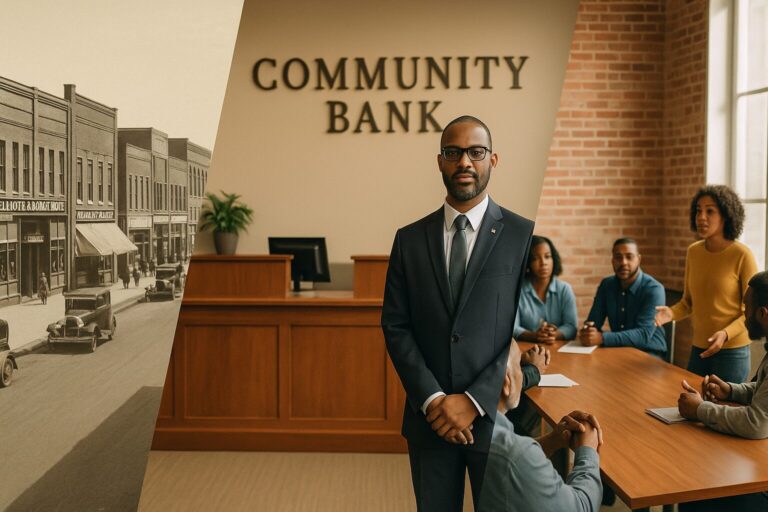Lessons from Tulsa, Nation of Islam Businesses, and Black Wall Street for Today’s Economy
When we talk about Black economic power, the talk often ends with inspiration and nostalgia. We praise past success stories — Greenwood’s Black Wall Street, the Nation of Islam’s enterprises, pockets of Black-owned commerce in cities across America — but too often fail to translate lessons into a replicable blueprint. If Black America is to build institutions that outlast any single leader or era, we must study the past with an eye toward disciplined, structural action today.
1) What made Greenwood (Black Wall Street) work — and what destroyed it
Greenwood in Tulsa was not an accident. It was a dense network of entrepreneurs, professionals, and community institutions: banks, insurance companies, schools, churches, newspapers, and cultural hubs. Its strengths:
- Circulation of the dollar: Money stayed local, building businesses and capital.
- Institutional layering: Businesses supported one another; profits funded schools and civic projects.
- Community governance: Local leaders coordinated investment and protection.
Its destruction in 1921 exposed how fragile even strong local ecosystems can be when external violence, racial hostility, and the absence of political protection combine. The lesson: build for resilience — legal, political, and economic — not just profitability.
2) What the Nation of Islam taught about scale, discipline, and enterprise
The Nation of Islam’s economic model in the mid-20th century shows how ideology, discipline, and organizational infrastructure can translate into tangible institutions: restaurants, real estate holdings, manufacturing, and printing presses. Key takeaways:
- Organizational discipline: Centralized leadership allowed fast mobilization of capital and labor.
- Vertical integration mindset: Controlling multiple steps of production and distribution kept margins and jobs local.
- Brand and trust: A shared identity produced customer loyalty and worker commitment.
That model wasn’t perfect — and it depended on tight leadership — but it demonstrates how cultural cohesion + organizational rigor = economic capacity.
3) Core principles of an institutions-first blueprint
From Greenwood and the NOI experience we can extract principles that are practical and modernizable:
- Keep money circulating locally. Encourage community purchasing, loyalty campaigns, and local supply chains so dollars stabilize neighborhoods instead of leaking away.
- Build layered institutions. Businesses should be paired with community banks, insurance, media, and education — a web of mutually supporting institutions.
- Own the means of capital formation. Capital is power. Credit unions, community development financial institutions (CDFIs), and local investment funds must be prioritized so credit decisions don’t depend on outside gatekeepers.
- Protect legally and politically. Institutional durability requires legal ownership structures (land trusts, cooperatives), political representation, and legal defense funds against predatory actors.
- Scale with governance. To survive leadership transitions, institutions need transparent governance, bylaws, boards, and succession plans — not personality-driven empires.
4) Concrete structures to build today
Translate principles into structures that can be started, scaled, and sustained:
- Community Land Trusts (CLTs): Secure land, keep housing affordable, and preserve community control over development.
- Community Banks & Credit Unions: Local capital for local businesses; conservative underwriting that understands community realities.
- Cooperative Business Networks: Worker- and consumer-owned co-ops in retail, construction, food distribution, and healthcare.
- Trade & Technical Schools Owned by the Community: Train local labor for local industry; pair education with guaranteed apprenticeships.
- Local Insurance Pools & Mutual Aid Funds: Protect institutions and families from shocks without bleeding capital to predatory insurers.
5) Policy levers that must change
Institutions don’t grow in a vacuum. They need a favorable policy environment:
- Zoning reform to allow mixed-use development and small-scale entrepreneurship in historically excluded neighborhoods.
- Targeted tax incentives that reward investment in Black-owned businesses and community institutions (not blanket abatements for outside developers).
- Public procurement reforms that prioritize local suppliers for municipal contracts.
- Stronger enforcement of fair-lending laws and capital programs that seed CDFIs and community banks.
6) A practical rollout plan — five steps for cities and counties
- Map assets: Conduct a community audit of existing businesses, banks, churches, and civic organizations.
- Create a community investment vehicle: Seed a local investment fund (via public-private match) to finance startups and real estate for CLTs.
- Stand up a local CDFI or expand an existing credit union: Make loans at scale with community underwriting criteria.
- Launch cooperative pilots: Start with essentials — groceries, childcare, home repair — where captured spending yields high returns.
- Institutional governance training: Train boards, develop succession plans, and mandate transparency.
7) Culture and accountability
Institutions need culture: a mindset shift from consumption to production, from short-term gains to multi-generational thinking. That requires education — not just financial literacy but civic education on ownership models, cooperative governance, and political leverage. It also demands accountability: measure outcomes (jobs created, dollars retained, homes owned), publish results, and pivot when strategies fail.
Conclusion — building an economy that lasts
Greenwood taught us what’s possible. The Nation of Islam model showed how organizational discipline and ideology can power an economy. The tragedy is not that these lessons are unknown — it’s that they’re rarely executed together into a strategic plan that centers ownership, capital formation, legal protection, and interlocking institutions.
If Black America wants institutions that outlast us, we must move from admiration to architecture. We must build the banks, land trusts, co-ops, training schools, and governance systems that turn temporary wins into permanent community power. That is the blueprint. The rest is work.




